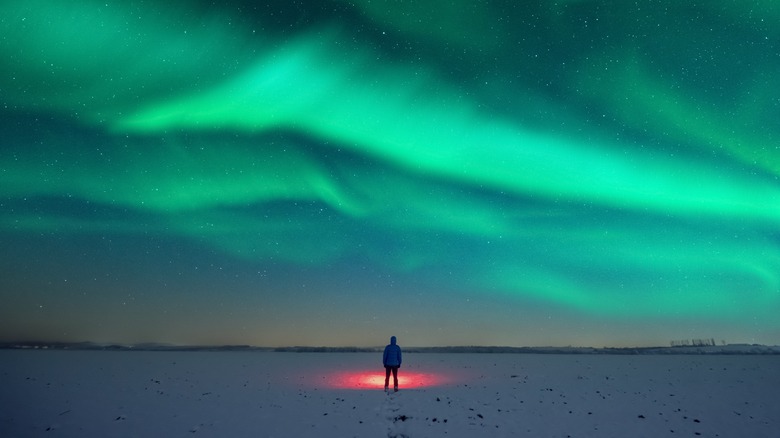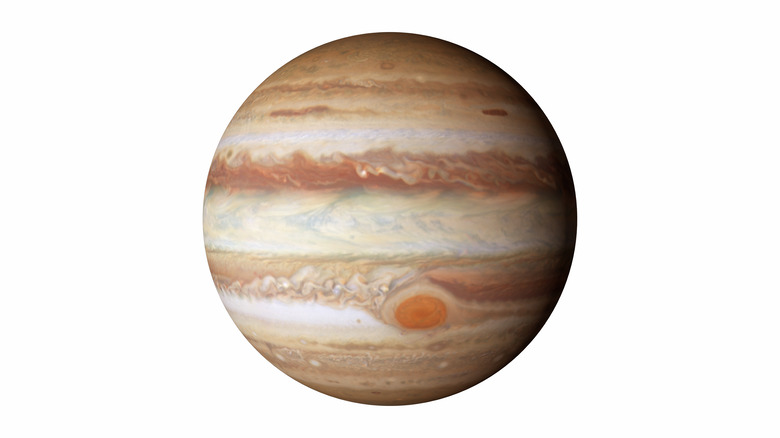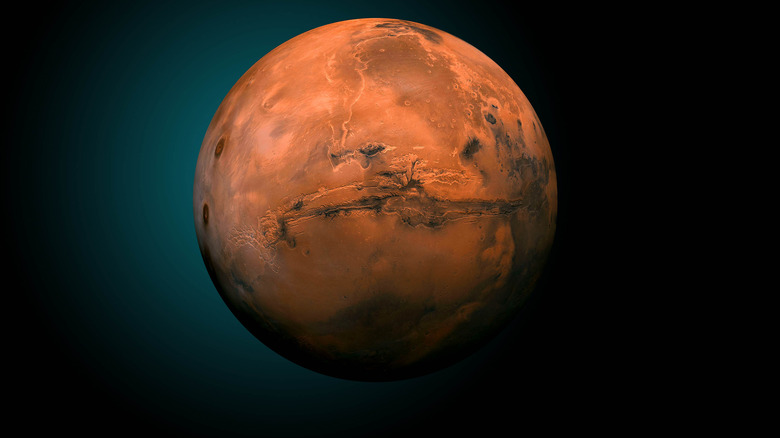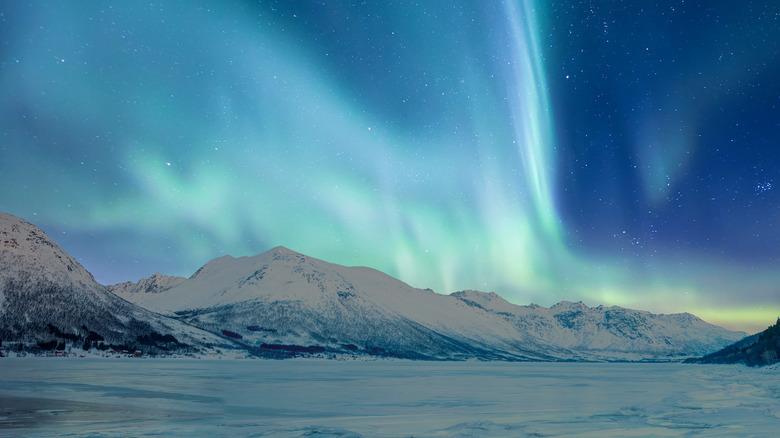The Northern Lights Are Not Just Something Unique To Earth
Auroras appear almost magically in the sky. Sometimes orange or red, they brighten the heavens with vivid colors like the rising or setting sun — so scarlet that the Native American Mandan tribe thought they were the cooking fires of "great divine warriors," reports The Vintage News. Other times, these waves of light appear green, violet or blue, or a mixture of tones; the color changes depending on the altitude and whether oxygen or nitrogen infuses the air. The phenomenon happens when solar wind and flares engage with the planet's magnetic field (via How Stuff Works).
But before science explained the heavenly skies, fables told their story. The ancient Chinese used the event as a way to show that gods did, indeed, exist, according to Future Science Leaders. The Greeks believed that the colors occurred as the goddess of the dawn, Aurora (aka Eos) — sister of sun god Helios and moon goddess Selene — sped through the heavens alerting her siblings that another day neared. The aurora borealis, or the northern lights, and the aurora australis, the southern lights, enchanted modern civilizations, too, according to The Vintage News. A Japanese superstition suggests that a baby receives special attributes — good looks, charm and intelligence — when conceived under an aurora-lit sky. While the northern lights appear in the country, some Japanese visit Alaska, Canada or Scandinavia to improve their odds for such a specially anointed child.
These colorful lights also appear in other places besides earth. While humans cannot visit them (yet), we can see them with the help of a telescope.
Why the planets have auroras
Both the Hubble Space Telescope and the Cassini probe have discovered that auroras exist on Jupiter and Saturn. Both massive gas giants contain the same conditions the smaller-sized Earth offers to create the brilliant spectacle: a place where solar winds and flares can interact with the planet's magnetic field, reports How Stuff Works. This also requires an atmosphere filled with ionic gases that can engage with electrons to produce those mystical hues.
Kristian Birkeland, a physicist from Norway, tested his hypothesis that auroras occurred after electrons, acquired from the sun, reacted with our planet's magnetic field (per Famous Scientists). His experiment created miniature auroras by using a spherical magnet and an electron gun placed in a vacuum chamber. While successful, his 1895 study on auroras failed to show the usual oval shape that normally appears in the sky. Later, as technology advanced scientists understood that electrons came from the magnetosphere rather than the sun, and that's what made them rounded.
Besides Earth, Saturn, and Jupiter, auroras also appear on other planets, such as Mars, Venus, and exoplanets — those orbs outside our solar system that circle a star. How auroras form there is different from other planets, though, according to Discover magazine. Auroras can also be seen on some moons, but not on earth; our celestial sphere's atmosphere (or lack of) doesn't allow it to form, said Web Exhibits. What is different about planets like Venus and Mars?
Why Mars and Venus have auroras
Venus does not possess a magnetic field. Yet, astronomers have looked at the planet and observed green streaks for more than 40 years, said Discover magazine. The appearance of these possible auroras puzzled them for decades. Then in 2014, some researchers noticed a reappearing phenomenon. Looking though a New Mexico telescope, they witnessed the appearance of green-tinged oxygen after solar storms. This, along with European Space Agency's Venus Express spacecraft data, suggested a theory that the sun's solar wind might reach Venus using the star's magnetic field alone — and that's what created the auroras.The red planet, Mars, sometimes glows with apparent auroras despite the challenges of having a minimal magnetic field and an orbit double the distance from the sun compared to Venus. Still, the remnants of Mars' magnetic field remain strong enough in places to make occasional auroras.
If you are looking for a show, Jupiter is the planet most likely to provide spectacular dancing lights. Like that gas giant it is, Jupiter goes big with everything, including auroras. After all, its magnetic field provides a punch some 20,000 times bigger than our humble planet, said Discover magazine. Plus, its moon, Io, adds to the charged particles the sun provides. A March 2021 study in AGU Advances indicated that Jupiter's "dawn storms" was produced by a similar auroral substorm on Earth. While Jupiter's probably occurs because of Io, on our planet changes in the magnetic field and solar wind make auroras appear.
Auroras outside the solar system
Even a planet outside our solar system offers an array of colors. Scientist insinuate that SIMP J01365663+0933473 (aka SIMP), a planet 95 light years from our sun, might beat out Earth and Jupiter for best in show, according to Astronomy. The planet packs a wallop with a magnetic field about 4 million times more powerful than Earth's. In comparison, Jupiter has a magnetic field about 20,000 times our planet. Like Jupiter, SIMP, which does not orbit a star, may have a moon that produces its auroras.
How SIMP's magnetic field remains so strong (over 200 times heftier than Jupiter's), reported Space, is a mystery, as its ability to produce auroras. What exactly SIMP is also provokes debate. "This object is right at the boundary between a planet and a brown dwarf or 'failed star,' and is giving us some surprises that can potentially help us understand magnetic processes on both stars and planets," said Melodie Kao, an astrophysicist at Arizona State University in a National Radio Astronomy Observatory statement, and the lead author of "The Strongest Magnetic Fields on the Coolest Brown Dwarfs." "We think these mechanisms can work not only in brown dwarfs, but also in both gas giant and terrestrial planets.
Until science works out the remainder of the details, you can enjoy the auroras Earth provides. To find the best places, the University of Alaska Fairbanks maintains an aurora forecast and the Space Weather Prediction Center monitors prime aurora viewing.



